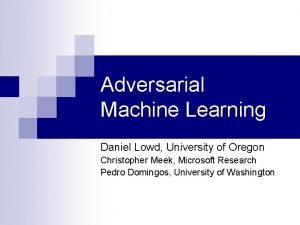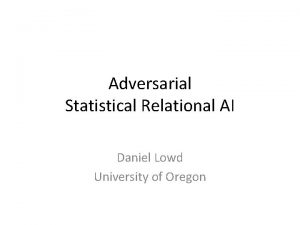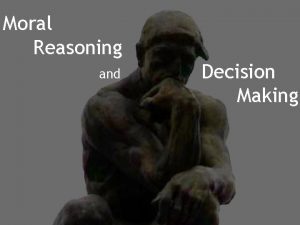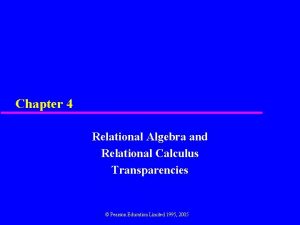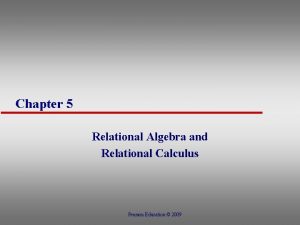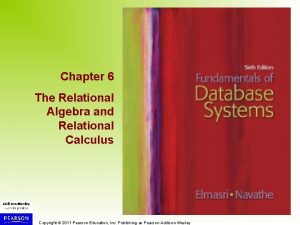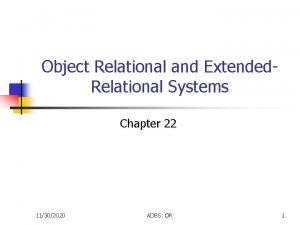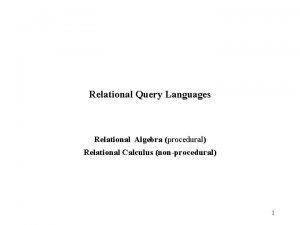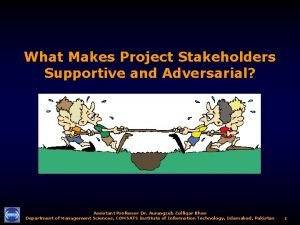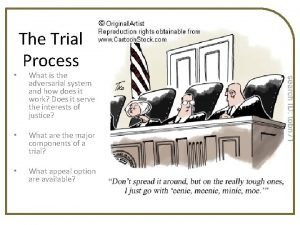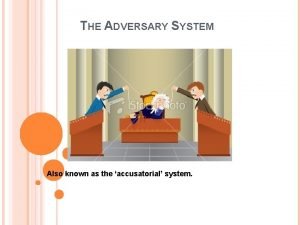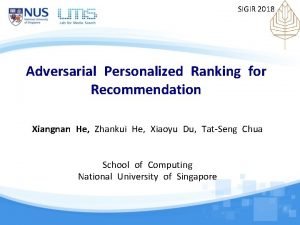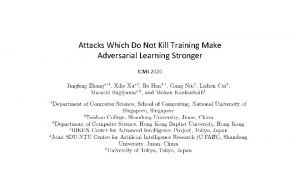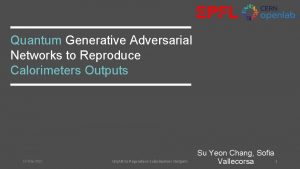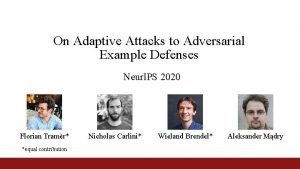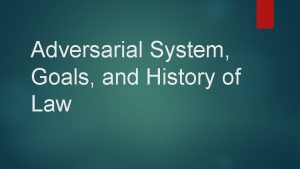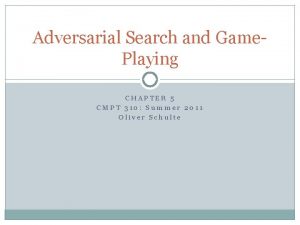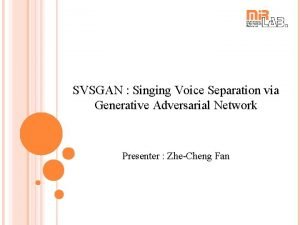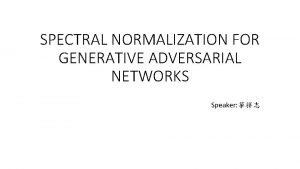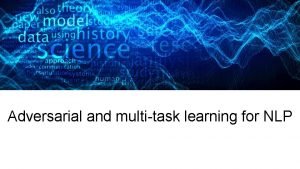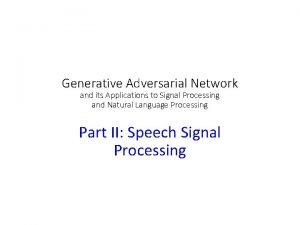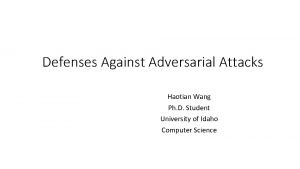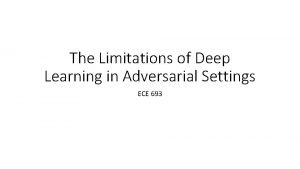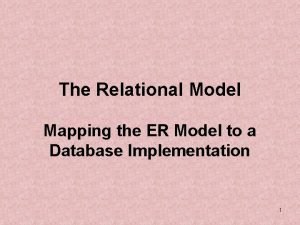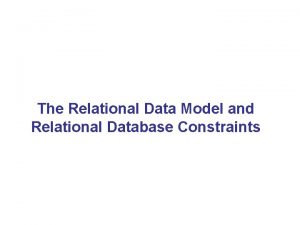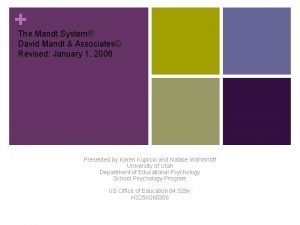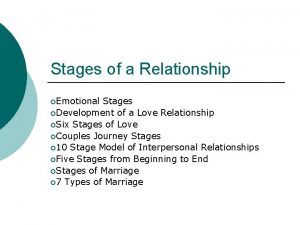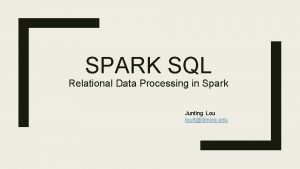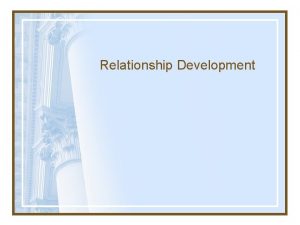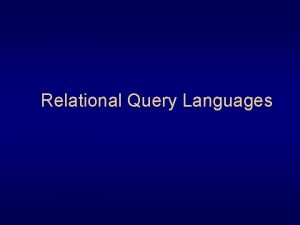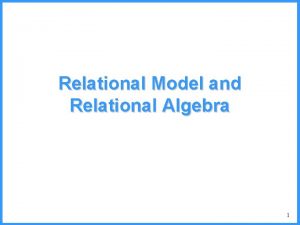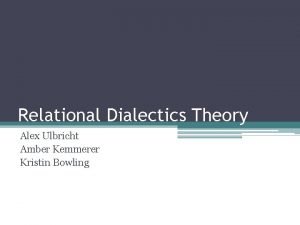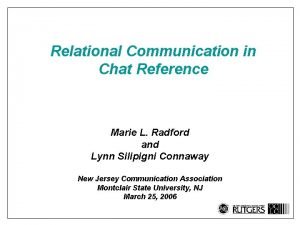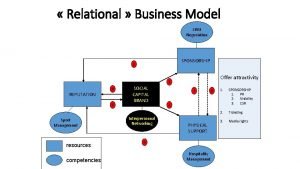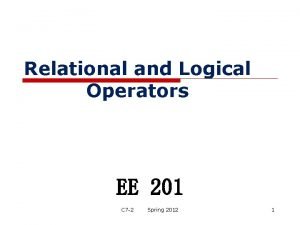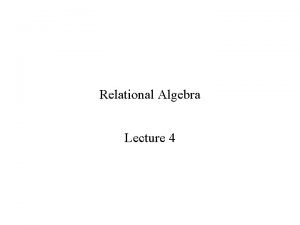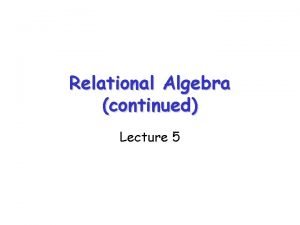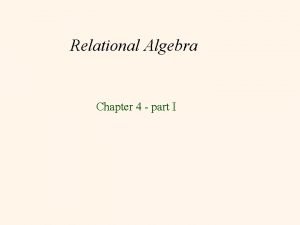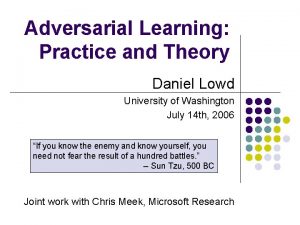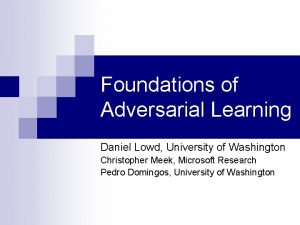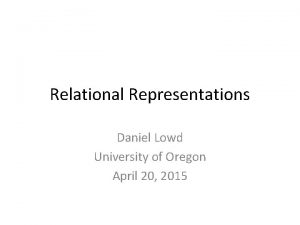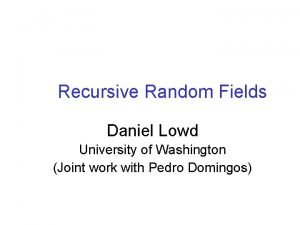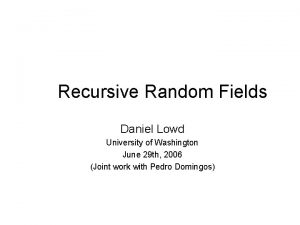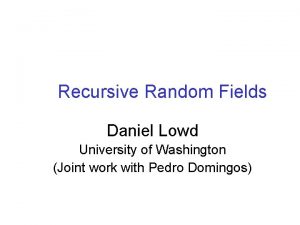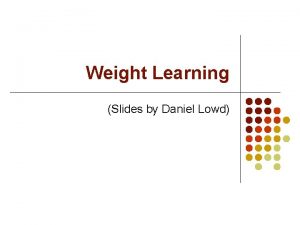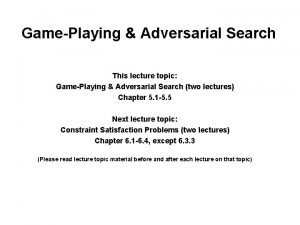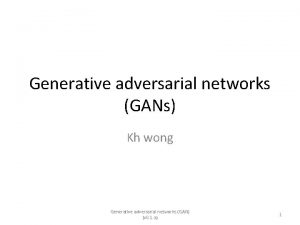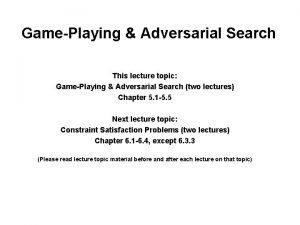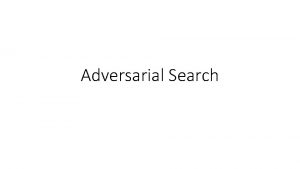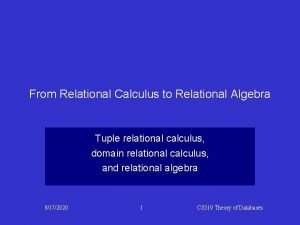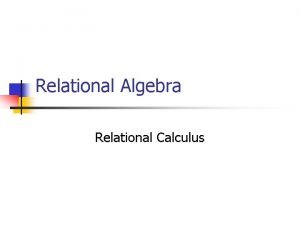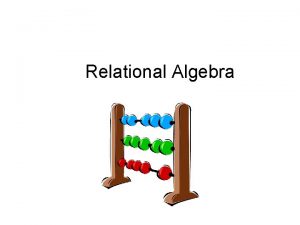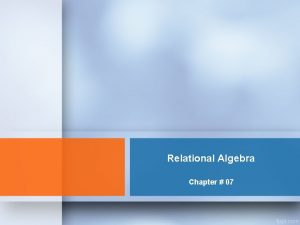Adversarial Statistical Relational AI Daniel Lowd University of
































![Experimental Methods Method Linear SVM-Invar [Teo&al 08] AMN [Taskar&al 04] Relational? No No Yes Experimental Methods Method Linear SVM-Invar [Teo&al 08] AMN [Taskar&al 04] Relational? No No Yes](https://slidetodoc.com/presentation_image/2cb88462d5470b68c5c61f687eb7900c/image-33.jpg)






![Ellipsoidal Uncertainty (c. f. [Xu et al. , 2009] for robustness of regular SVMs. Ellipsoidal Uncertainty (c. f. [Xu et al. , 2009] for robustness of regular SVMs.](https://slidetodoc.com/presentation_image/2cb88462d5470b68c5c61f687eb7900c/image-40.jpg)












- Slides: 52

Adversarial Statistical Relational AI Daniel Lowd University of Oregon

Outline • Why do we need adversarial modeling? – Because of the dream of AI – Because of current reality – Because of possible dangers • Our initial approach and results – Background: adversarial learning + collective classification – Robustness through adversarial simulation [Torkamani & Lowd, ICML’ 13] – Robustness through regularization [Torkamani & Lowd, ICML’ 14] 2

What is Star. AI? “Theoretically, combining logic and probability in a unified representation and building general-purpose reasoning tools for it has been the dream of AI, dating back to the late 1980 s. Practically, successful Star. AI tools will enable new applications in several large, complex real-world domains including those involving big data, social networks, natural language processing, bioinformatics, the web, robotics and computer vision. Such domains are often characterized by rich relational structure and large amounts of uncertainty. Logic helps to effectively handle the former while probability helps her effectively manage the latter. We seek to invite researchers in all subfields of AI to attend the workshop and to explore together how to reach goals imagined Thethedream of AI: by the early AI pioneers. ” [www. starai. org] Unifying logic and probability! 3

Who is Star. AI? “Specifically, the workshop will encourage active participation from researchers in the following communities: • satisfiability (SAT) • knowledge representation (KR) • constraint satisfaction and programming (CP) • (inductive) logic programming (LP and ILP) • graphical models and probabilistic reasoning (UAI) • statistical learning (NIPS, ICML, and AISTATS) • graph mining (KDD and ECML PKDD) • probabilistic databases (VLDB and SIGMOD). ” [www. starai. org] 4

Who is Star. AI? “It will also actively involve researchers from more applied communities, such as: • natural language processing (ACL and EMNLP) • information retrieval (SIGIR, WWW and WSDM) • vision (CVPR and ICCV) • semantic web (ISWC and ESWC) • robotics (RSS and ICRA). ” [www. starai. org] Almost everyone doing AI research! 5

Statistical Relational AI • The real world is complex and uncertain • Logic handles complexity • Probability handles uncertainty 6

Adversarial Statistical Relational AI • The real world is complex, uncertain, and adversarial • Logic handles complexity • Probability handles uncertainty • Game theory handles adversarial interaction • Include researchers in multi-agent systems (AAMAS) and security (CCS) If you want to unify AI, why stop with logic and probability? 7

Outline • Why do we need adversarial modeling? – Because of the dream of AI – Because of current reality – Because of possible dangers • Our initial approach and results – Background: adversarial learning + collective classification – Robustness through adversarial simulation [Torkamani & Lowd, ICML’ 13] – Robustness through regularization [Torkamani & Lowd, ICML’ 14] 8

Example: Social Network Spam Which users are spammers? Image credit: [Fakhraei et al. , 2015] 9

Example: Fraud Detection in Online Auctions Which people are fraudsters or accomplices? Image credit: [Chau&al 06] 10

Example: Securities Dealers Which brokers are likely to receive complaints in the future? Image credit: [Neville&Jensen 07] 11

More Examples • • Web spam Worm detection Fake reviews Counterterrorism Common themes: 1. Adversaries can be detected by their relationships as well as their attributes. 2. Adversaries may change their behavior to avoid detection. 12

Outline • Why do we need adversarial modeling? – Because of the dream of AI – Because of current reality – Because of possible dangers • Our initial approach and results – Background: adversarial learning + collective classification – Robustness through adversarial simulation [Torkamani & Lowd, ICML’ 13] – Robustness through regularization [Torkamani & Lowd, ICML’ 14] 13

Robustness and Safety in AI • Many AI systems interact with people – this is a vulnerability and a liability. • How can we know that an AI system is correct, safe, or robust? • Adversarial reasoning and modeling can help build more robust systems by optimizing pessimistically. 14

Related Work on Multi-Agent Star. AI • Poole, 1997: Independent Choice Logic • Rettinger et al. , 2008: A Statistical Relational Model for Trust Learning • Lippi, 2015: Statistical Relational Learning for Game Theory 15

Outline • Why do we need adversarial modeling? – Because of the dream of AI – Because of current reality – Because of possible dangers • Our initial approach and results – Background: adversarial learning + collective classification – Robustness through adversarial simulation [Torkamani & Lowd, ICML’ 13] – Robustness through regularization [Torkamani & Lowd, ICML’ 14] 16

Special Case: Static Prediction Games • In general, we may have arbitrary agents, utility functions, and game structures. Hard. • Prediction games – First player chooses the model (e. g. , spam filter) – Second player chooses the test data (e. g. , spam) • Domains: Social network spam, online auction fraud, bad securities dealers, web spam, fake reviews, and more! 17

Example: Spam Filtering 1. From: spammer@example. com Cheap mortgage now!!! Feature Weights 2. 3. cheap = 1. 0 mortgage = 1. 5 Total score = 2. 5 > 1. 0 (threshold) Spam 18

Example: Spammers Adapt 1. From: spammer@example. com Cheap mortgage now!!! Eugene Oregon Feature Weights 2. 3. cheap = 1. 0 mortgage = 1. 5 Eugene = -1. 0 Oregon = -1. 0 Total score = 0. 5 < 1. 0 (threshold) OK 19

Example: Classifier Adapts 1. From: spammer@example. com Cheap mortgage now!!! Eugene Oregon Feature Weights 2. 3. cheap = 1. 5 mortgage = 2. 0 Eugene = -0. 5 Oregon = -0. 5 Total score = 2. 5 > 1. 0 (threshold) Spam OK 20

Adversarial Classification as a Game • Learner selects a classifier c. • Adversary selects modified evidence x. • Each receives a reward based on how correct the classifier was and how corrupt the evidence was. Previous work: Assumes instances are independent! (e. g. , Dalvi&al 04; Globerson&Roweis 06; Teo&al 08; Dekel&Shamir 08; Xu&al 09; Brückner&Scheffer 11) 21

Collective Classification Label a set of objects using the relationships among them as well as their attributes. 22

Markov Logic Networks A Markov Logic Network (MLN) is a log-linear model where the features are counts of satisfied formulas. Given a finite set of constants, this defines a probability distribution over possible worlds: Weight of formula i No. of true groundings of formula i in x Conditional distribution of query atoms (y) given evidence (x): 23

Markov Logic Networks for Collective Classification 1. The label for an object o depends on its attributes: Has. Attribute(o, +a) ⇒ Label(o, +c) 2. Related objects are more likely to have similar labels: Related(o, o’) ∧ Label(o, +c) ⇒ Label(o’, +c) Create copies of these rules for each class and attribute, and then learn a weight for each rule. 24

Max-Margin Weight Learning Goal: Select w to maximize the margin between true labeling and any alternate labeling. Maximize the margin + weighted slack variable Score of the true labeling Score of an alternate labeling Differences between the labelings 25

Max-Margin Weight Learning Goal: Select w to maximize the margin between true labeling and any alternate labeling. Learner’s loss from the best alternate labeling (biggest margin violation) L 2 regularizer on the weights. 26

Special Case: Associative Markov Networks • If the weights of the second formula are positive, then linked nodes are more likely to have the same label: • Inference can be done in polynomial time with graph cuts or as a linear program. [Kolmogorov&Zabin 04] • Learning can be done in polynomial time with a convex quadratic program. [Taskar&al 04] 27

Outline • Why do we need adversarial modeling? – Because of the dream of AI – Because of current reality – Because of possible dangers • Our initial approach and results – Background: adversarial learning + collective classification – Robustness through adversarial simulation [Torkamani & Lowd, ICML’ 13] – Robustness through regularization [Torkamani & Lowd, ICML’ 14] 28

Adversarial Collective Classification We want to robustly label related entities who are actively working to avoid detection. Assume: Adversary can modify up to D attributes. (e. g. , add/remove words from spam web pages) 29

Convex Adversarial Collective Classification Modify our associative Markov network by assuming a worst-case adversary: s. t. Enforce a margin between true labeling and alternate labeling given worst-case adversarially modified data. 30

Convex Adversarial Collective Classification Reformulating as a quadratic program: 1. Remove bilinearities in the score function by introducing auxiliary variables. 2. Replace the inner maximization with its dual minimization problem. Theorem: For binary-valued labels and features, the adversary’s maximization has an integral solution. Thus, the relaxed learning problem is exact. (Can be extended with multiple types of relations, as long as all are associative. ) 31

Datasets • Political blogs – 2004 blog data collected by Adamic (2005) – We recrawled in February 2012 and May 2012 to add words, remove dead blogs. – Selected 100 words with mutual information • Reuters – 4 classes from the Mod. Apte split: crude, grain, trade, money-fx – Split into 7 time periods, each with 300 -400 articles – Added links to 2 most similar articles (TF-IDF) – Selected 200 words with mutual information 32
![Experimental Methods Method Linear SVMInvar Teoal 08 AMN Taskaral 04 Relational No No Yes Experimental Methods Method Linear SVM-Invar [Teo&al 08] AMN [Taskar&al 04] Relational? No No Yes](https://slidetodoc.com/presentation_image/2cb88462d5470b68c5c61f687eb7900c/image-33.jpg)
Experimental Methods Method Linear SVM-Invar [Teo&al 08] AMN [Taskar&al 04] Relational? No No Yes Adversarial? No Yes No CACC [Torkamani&Lowd 13] Yes Tuning: Select parameters to maximize performance on validation data against adversary who could modify 10% of the attributes. Evaluation: Measured accuracy on test data against simulated adversaries with budgets from 0% to 25%. 33

Results: Political Blogs, Tuned for 10% adversary 34

Results: Reuters, Tuned for 10% adversary 35

Weight Distribution Intuitively, if an adversary can change some of the attributes then we want to avoid placing high weights on any attributes. CACC does this automatically: Maximum weight? 36

Adversarial Regularization • Empirically, optimizing performance against a simulated adversary can lead to bounded weights. • What if we avoid simulating the adversary and instead just bound the weights? • We can show that the two are equivalent! (Under a slightly different adversarial model than we used before. ) • More generally, we can achieve adversarial robustness on any structured prediction problem by adding a regularizer. 37

Adversarial Model • Previously, we assumed the adversary could modify the evidence, x, by a small number of changes. • Now we assume that the adversary can modify the feature vector, φ(x, y), by a small vector δ/2. – Thus, they can modify the difference between two feature vectors, φ(x, y’) – φ(x, y), by δ. – Thus, they can modify the difference between two scores, score(w, x, y’) – score(w, x, y), by w. Tδ. 38

Optimization Problem ‘ Which is equivalent to: ‘ 39
![Ellipsoidal Uncertainty c f Xu et al 2009 for robustness of regular SVMs Ellipsoidal Uncertainty (c. f. [Xu et al. , 2009] for robustness of regular SVMs.](https://slidetodoc.com/presentation_image/2cb88462d5470b68c5c61f687eb7900c/image-40.jpg)
Ellipsoidal Uncertainty (c. f. [Xu et al. , 2009] for robustness of regular SVMs. ) Suppose the adversary is constrained by a norm: Theorem: Robustness over S is equivalent to adding the dual norm as a regularizer: ‘ Special case: For L 1 ball, the dual norm is (max). 40

Polyhedral Uncertainty Suppose the adversary is constrained to a polyhedron: Theorem: Robustness over S is equivalent to adding a linear regularizer in a transformed weight space: We can also let S be the intersection of a polyhedron and an ellipsoid and obtain a generalization of both results. 41

Robustly Classifying 11 years of Political Blogs • Goal: Label each blog as liberal or conservative • Political blogs dataset (Adamic and Glance, 2005) + bag-of-words features from each year • Train/tune on 2004 and test on every year. • Robust model: Assume adversary can modify up to k words and k links. Iraq War 2003 2004 2005 2006 2007 2008 2009 2010 2011 2012 2013 42

43

Ongoing Work: Large-Scale Applications • • Comment spam on You. Tube Abuse and spam on Sound. Cloud Social network spammers on Tagged. com Fraudulent images (DARPA Medi. For program) Challenges: • Multiple types of relations • Complex adversaries • Millions of objects to label 44

Detecting Spammy Comments URL 1 http: //…/spammy 1. html Similarity Score: 0. 9 URL 2 http: //…/cats. html URL 3 http: //…/spammy 2. html 45

Detecting Spammy Comments URL 1 http: //…/spammy 1. html Similarity Score: 0. 9 URL 2 http: //…/cats. html URL 3 http: //…/spammy 2. html 46

Detecting Spammy Comments URL 1 http: //…/spammy 1. html Similarity Score: 0. 9 URL 2 http: //…/cats. html URL 3 http: //…/spammy 2. html 47

Detecting Spammy Comments URL 1 http: //…/spammy 1. html Similarity Score: 0. 9 URL 2 http: //…/cats. html URL 3 http: //…/spammy 2. html 48

Detecting Spammy Comments URL 1 http: //…/spammy 1. html Similarity Score: 0. 9 URL 2 http: //…/cats. html URL 3 http: //…/spammy 2. html 49

Adversary Response URL 1 http: //…/spammy 1. html Similarity Score: 0. 9 URL 2 http: //…/cats. html URL 3 http: //…/spammy 2. html 50

Open Questions • Non-zero-sum games • Representing strategies: Weights, decision nodes, distributions? • Integrate with planning, reinforcement learning • When is adversarial modeling unnecessary? • Best methods for validating adversarial models (outside of industry) 51

Conclusion • Star. AI needs adversarial modeling – To fulfill long-term AI vision – To solve current applications – To improve robustness/safety • Two ways to learn robust relational classifiers: – Embed the adversary inside the optimization problem – Construct an equivalent regularizer (Special case: set a maximum weight!) – Empirically, these models are robust to malicious adversaries and non-malicious concept drift. • Many open questions and challenges! 52
 Daniel lowd
Daniel lowd Daniel lowd
Daniel lowd What is moral reasoning
What is moral reasoning Relational algebra and calculus
Relational algebra and calculus Relational calculus
Relational calculus The relational calculus is considered as
The relational calculus is considered as Object relational and extended relational databases
Object relational and extended relational databases Relational algebra and relational calculus
Relational algebra and relational calculus Adversarial stakeholders
Adversarial stakeholders Adversial system
Adversial system Adversary system definition
Adversary system definition Hexiangnan
Hexiangnan Friendly adversarial training
Friendly adversarial training Quantum generative adversarial learning
Quantum generative adversarial learning Neur ips
Neur ips Adversarial interview
Adversarial interview Adversarial system law definition
Adversarial system law definition Adversarial search problems uses
Adversarial search problems uses Adversarial examples
Adversarial examples Generative adversarial network
Generative adversarial network Spectral normalization gan
Spectral normalization gan Conditional generator
Conditional generator Adversarial multi-task learning for text classification
Adversarial multi-task learning for text classification Voice conversion
Voice conversion Adversarial training
Adversarial training Nicolas papernot
Nicolas papernot The limitations of deep learning in adversarial settings
The limitations of deep learning in adversarial settings Adversarial patch
Adversarial patch Generative adversarial networks
Generative adversarial networks Daniel cohan rice university
Daniel cohan rice university 沈榮麟
沈榮麟 Perceptual barriers
Perceptual barriers Company relational database schema
Company relational database schema Mapping of er model to relational model
Mapping of er model to relational model Relational model constraints
Relational model constraints Crisis cycle mandt
Crisis cycle mandt Susan campbell relationship stages
Susan campbell relationship stages Spark sql: relational data processing in spark
Spark sql: relational data processing in spark Man is a relational being
Man is a relational being List the stages in knapp's relationship termination model
List the stages in knapp's relationship termination model Circumscribing relationship stage
Circumscribing relationship stage Relational query languages in dbms
Relational query languages in dbms Conditional join relational algebra
Conditional join relational algebra Predictability vs novelty example
Predictability vs novelty example Advantages of relational database model
Advantages of relational database model Logical view of data
Logical view of data Relational dimension of communication
Relational dimension of communication Sponsorship business model
Sponsorship business model Relational operators
Relational operators Natural join operation
Natural join operation Relational algebra conditional join
Relational algebra conditional join Relational algebra
Relational algebra Relational algebra
Relational algebra
